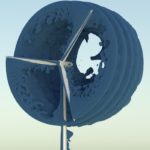A wind power revolution is blowing through the U.S. electrical industry, and exascale-class supercomputing is expected to play an increasingly instrumental role in its growth. The Energy Information Administration puts wind power’s share of America’s electricity generation at 8.4 percent in 2020, up from less than 1 percent in 1990. Increasingly competitive on cost and […]
ExaWind: How Exascale-class HPC Will Help Optimize Skyscraper-sized Wind Turbines of the Future
Video: Optimizing Wind Power with the ExaWind Project at NREL
In this video, Scott Gibson discusses the ExaWind project for windmill simulation with Michael Sprague from NREL. ExaWind is part of the ECP, which is building applications that will scale to tomorrow’s Exascale machines. “Sprague also explains why the simulation is important because it demonstrates that the physics models of the ExaWind team will perform well on large computers and paves the way for the team to improve the models and direct simulation capability toward the exascale platform when it’s ready. He added that, ultimately, the team plans to simulate tens of large turbines within a large wind farm.”
Supercomputing Turbine Energy with the ExaWind Project
ECP’s ExaWind project aims to advance the fundamental comprehension of whole wind plant performance by examining wake formation, the impacts of complex terrain, and the effects of turbine-turbine wake interactions. When validated by targeted experiments, the predictive physics-based high-fidelity computational models at the center of the ExaWind project, and the new knowledge derived from their solutions, provide an effective path to optimizing wind plants.






